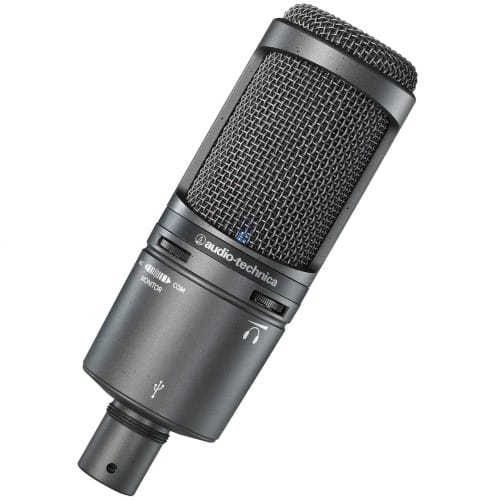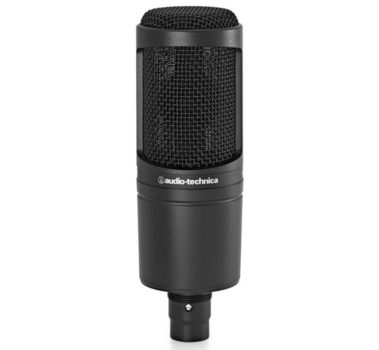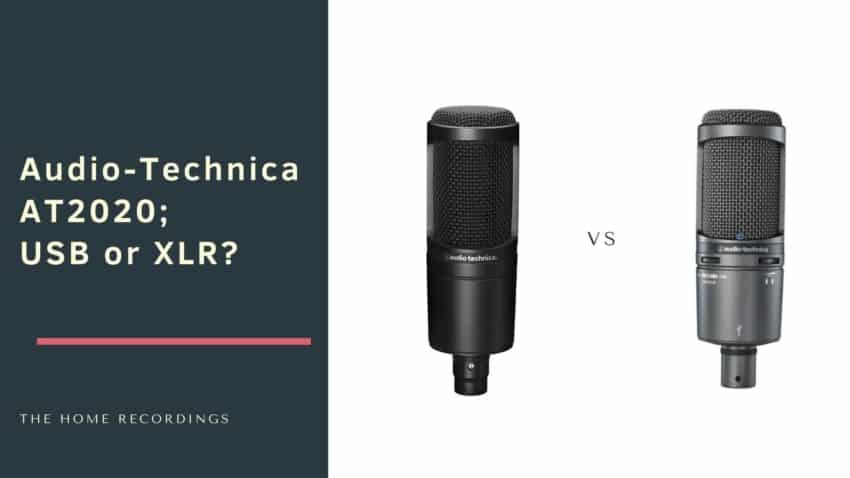Last updated on December 30th, 2023 at 02:58 pm
The Audio-Technica AT2020 has been the standard microphone for most home recording studios for years now due to its great sound quality at a very affordable price.
However, there’s also the USB version of the AT2020, and are there any differences between the two? Is one better than the other?
In this article I will answer these questions and also tell you which one to go for depending on your needs.
AT2020 XLR vs AT2020 USB
Both microphones are identical in both sound- and built-quality, but the difference lies in that the AT2020 USB comes with Gain and Headphone Mix controls and doesn’t require any additional gear to work.
The AT2020 XLR needs an Audio Interface, Mixer, or other equipment to work, and doesn’t come with any additional features.
Let’s have a quick overview of both microphones as well as go over some advantages and disadvantages of both microphone formats, and lastly which one you should get… and yes, there is one that is definitely better than the other in 90% of situations.
USB AT2020 Overview

The AT2020 USB comes with a built-in headphone jack that allows you to do direct zero-latency monitoring, and you can control this with the Mix knob that will control how much of the microphone’s direct signal vs how much of the computer’s audio will be played back.
Of course, a Gain dial is also available to let you manage the level of the signal; however, no LED lights are available to give you a visual representation of what’s going on and you will have to check that in the recording software itself.
As far as the build quality goes, it’s just great, but this is also the case with all the Audio-Technica microphones, so no surprises here.
Now, what about the sound quality?
The AT2020 USB has always been my go-to recommendation as far as USB microphones go, not because of its versatility, since it only features a cardioid polar pattern, but rather because of the audio quality;
When compared to other USB microphones out there, the audio is just excellent and it can definitely be used to record great-sounding music.
Now, like it tends to happen with microphones in this price range, it has a slight bump in the mid-high frequencies, making the sound a bit crispy at times, but you might like that, and it’s also nothing that can’t be fixed with a bit of EQ.
Lastly, it can record with a sample rate of 44.1kHz or 48kHz/16-bit.
Find out more about the AT2020 USB here.
- Audio-Technica AT2020 USB: Amazon, Sweetwater.
XLR AT2020 Overview

If there is one microphone that most beginner/intermediate music production enthusiasts buy, it’s the XLR version of the AT2020; It’s affordable, sounds great, and it’s built to last.
In fact, most professional studios have a couple of those lying around that they use more often than you’d think.
The build quality is fantastic, even better than the one of more expensive microphones, and it should last you forever if you take good care of it.
It doesn’t come with a PAD or a High-Pass filter, but this is to be expected at this price point.
The sound quality is great; it does have a slight bump in the higher mid frequencies that can bring out some crispiness from time to time, but this can definitely be EQ’d out.
But that’s really it; it’s a microphone with no bells and whistles that jut does what it’s supposed to at a very low price.
Another great alternative to the AT2020 is the Rode NT1-A, which is a bit higher priced, but definitely sounds more professional.
Find out more about the Audio-Technica AT2020 here.
Audio-Technica AT2020: Amazon, Sweetwater.
Here’s a hugely important piece of information that you should know before deciding:
USB vs XLR microphones
As far as the two microphones addressed in this post go, there isn’t really any difference in build- or audio quality, but there are a couple key points to take into consideration when deciding what kind of microphone to get, since one is usually better than the other, at least for most people.
Ease of Use
USB Microphones are plug and play, which simply means that you connect them to a computer and that’s it, they are ready to be used.
This makes them great for beginners because they don’t need to learn how an Audio Interface or a Mixer works and having to deal with drivers won’t even come into play.
On the other hand, going for an Audio Interface and XLR microphones will require you to install drivers, connect the mics to the interface and the interface to the computer, etc., basically, it’s a bit more complex.
Versatility
The most important thing to know is that with a USB mic you won’t have the need for any additional equipment; all you need is the microphone and a computer, and that’s it.
Even phantom power will be supplied to the microphone over the USB cable.
Now, since USB microphones can only be used when connected directly to a computer, this also means that if you want to expand your rig, you’ll have to ditch the USB microphone and purchase a separate Audio Interface and new XLR microphones, and this will end up being more expensive.
XLR microphones are much more versatile because they can be used with almost any other recording equipment out there; Audio Interfaces, Mixers, Portable Recorders, etc.
Unless you’re 100% certain that you will need just the one microphone, then the XLR alternative is much more versatile, plus there are a lot more microphones available in an XLR format.
Price
The AT2020 USB is more expensive than the AT2020 XLR, but you need to remember that the AT2020 in XLR format will require at least a 1-input audio interface, making the initial investment on par with the USB mic, or even higher.
However, the best way to go about it is to purchase an audio interface – one with two or more inputs would be ideal- and get the AT2020 XLR.
The reason for this is that, on the one hand, you will be able to record multiple tracks, but more importantly, imagine having bought the AT2020 USB only to find that you will need to record one or two additional tracks simultaneously?
You will have to get an Audio Interface and XLR microphones anyway, and what you spent on the USB microphone will be wasted.
Audio Quality
Even though the microphones might be identical in every way, there might be a slight difference in audio quality due to the cables;
XLR cables are designed to filter out any unwanted noises, and this yields a better recording.
These would be the basic key points on the differences between XLR and USB microphones, however I wrote an entire post about this topic that you should definitely read as well.
My recommendation
The simple answer is the XLR Microphone (AT2020 XLR).
The reason for this is versatility; you can record using a multitude of equipment, you don’t need to get rid of it like you would when upgrading from a USB mic to an Audio Interface, USB microphones only allow you to record one track at a time while with an Audio Interface you can record as many tracks as the interface will let you (of course, you would need more microphones as well), etc.
For musicians or podcasters, getting an Audio Interface + some XLR microphones is definitely the best way to go.
If you’re someone who makes YouTube content, streams videos, does voice-over work, or any other sort of work where only one microphone is required, then a USB mic should do the trick.
However, I still believe that going the XLR route + Audio Interface is much better for most people.
Lastly, USB microphones are responsible for the Analog to Digital conversion, while with XLR ones the Audio Interface takes care of this, and they usually do a better job at it as well resulting in higher audio quality.
Here’s a post about two affordable and great-sounding Audio Interfaces that should help you out!
Conclusion
USB microphones definitely have their place, especially for either beginners or people who need one input and one input only.
But upgrading can be a hassle and end up costing you more in the long run.
So, in most of the cases, you should go with an XLR mic.
I hope this information was useful!
Have a nice day!

Hello Facundo,
Firstly, may I say that your article generally relating to the AT2020 (XLR) vs AT2020 (USB)
was extremely helpful, although I just need a little help & advice regarding drivers in the case of an AT2020XLR set up.
He has a Behringer XENYX QX1204 usb mixer, a laptop and presently uses an AKG Wireless mic which has been serving him quite well for a couple of years.
However, he wants to progress to doing more things on his laptop via new mic & mixer.
It took me a while to suss out the difference between the AT XLR & USB version, meaning if my son went for the XLR he’d have to have buy an audio interface to make this possible
and necessary to have 48v phantom power and a usb printer type socket at the rear of the
Mixer.
Then I realized that in your article that you mentioned that this method could be achieved
by putting it through his USB mixer which makes an independent audio interface module
unnecessary.
So all the ‘ingredients’ are there i.e. a condenser mic to plug into any of the 4 XLR mic sockets on the mixer, and mixer usb to the laptop, but there’s one more thing my so needs to know and that’s how to install the DRIVERS on the laptop. Could you please talk me through it.
You also wrote the article about an AT2020 vs Rode NT-1A.
I did some research and made a last minute decision after discovering the newer
Rode NT-1 (not the A version) – the kit version complete with XLR cable, pop shield & shockmount for a fair price. It should arrive tomorrow!
Kind regards
Brian Chapman
Bill Young, you can buy a Microphone stand and put the mic there, it will help reduce the noise being picked up by the computer fan, also, you might want to reduce the gain so it doesn’t pick the sound.
That’s what I did, the XLR version (with a Focusrite Scarlett Solo). It’s good. Perhaps too good, as I can hear my computer fan. I have ordered a shock-mount to hang from the ceiling. Does that seem sensible?